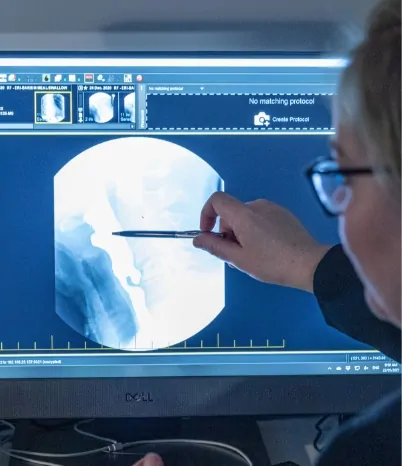
Benign Head & Neck
Non-cancerous neck conditions
What is the most common cause of a lump in the neck?
Neck lumps are very common, and are most often due to swollen lymph nodes. You have over a 100 lymph nodes in your neck, which form part of your immune system. Lymph nodes swell in response to infection. They can also enlarge as a result of other inflammatory processes, such as autoimmune disease.
Where else could a benign neck lump come from?
Non-cancerous masses may develop from various structures in the neck, including:
- Skin
Abscesses and sebaceous cysts are non-cancerous. Many skin moles are also benign.
- Fat tissue
A lipoma is a type of non-cancerous growth arising from fat tissue.
- Nerve tissue
A neuroma is a benign growth that develops from nerve tissue.
- Blood vessels.
An aneurysm is a ballooning of a weakened blood vessel wall. A vascular tumour is a growth that arises from blood vessel tissue.
Some benign growths of the neck, such as neck cysts, may be congenital. (A cyst is a fluid-filled sac which is usually not cancerous). A congenital cyst occurs as a result of a slight abnormality during foetal development, although it may be noticed for the first time later in life. The most common congenital neck cyst is a thyroglossal duct cyst, and it occurs along the midline of the neck. Another common congenital neck cyst is know as a branchial cleft cyst and most commonly occurs on the side of the neck under the jaw.
Non-cancerous salivary gland conditions
What are my salivary glands?
Your salivary glands produce saliva, and empty it into your mouth through openings called ducts. You have 3 pairs of major salivary glands, namely:
- Parotid glands
The biggest salivary glands, these are found on the insides of your cheeks.
- Submandibular glands
These are located below your jaw.
- Sublingual glands
These are the smallest of the major salivary glands and are found beneath your tongue.


What kind of salivary gland problems occur?
There are various problems that can affect salivary glands. These include:
- Sialoliths (Salivary stones)
Salivary stones form from crystallised saliva. If a siaololith blocks a salivary duct, the salivary gland becomes swollen and painful.
- Sialoadenitis (Salivary gland infection)
If a salivary duct is blocked, bacterial infection of the salivary gland is likely to occur. This causes a painful lump in the salivary gland, and a horrible taste in the mouth. If left untreated, sialoadenitis can develop into an abscess, causing severe pain and high fever.
- Other infections
Various viral infections, such as mumps, can cause swelling of the parotid glands.
- Salivary gland growths
Approximately 80% of salivary gland growths are benign. Non-cancerous salivary gland growths include cysts, pleomorphic adenomas and Warthin’s tumours.
- Sjögren’s syndrome
This is a chronic autoimmune condition, which leads to dry mouth and eyes. It often causes painless enlargement of the salivary glands.
If you have a head or neck lump that concerns you and requires further investigation, or a problem with your salivary glands, your GP may refer you to an ENT specialist.
Dr Julia Crawford is specialised in diagnosing and managing these conditions, and is able to provide the treatment and care that you need. If you have your GP referral, please call our office on 02 8319 9434 to arrange for a consultation at our rooms in Darlinghurst or Kogarah.

